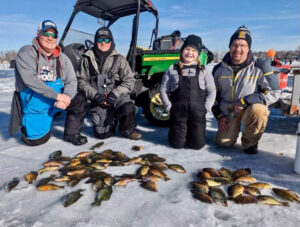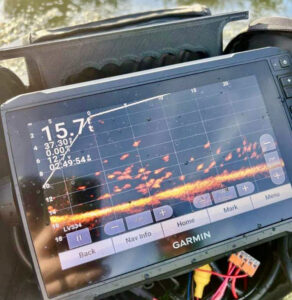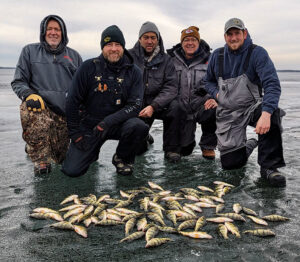By Steve Weisman
What an ice fishing season this has been, or perhaps hasn’t been! After all, the season never started until early January, and unless weather conditions return with 30-degree for highs and teens for lows, the season might be over. However, even as we begin to put our ice fishing gear away, there is one last thing we can do. We can take a look at what went right, what went wrong and what we’d like to know more about.
I came on this idea after a recent visit with Shane Akin, owner of the Great Lakes Guide Service. During our visit, we talked about how hole-hopping has changed. For as many years as I can remember, anglers have tried to follow the schools of fish, often drilling holes, and then fishing, while trying to keep up with the movement of the school. Often times, you watched the anglers around you. See a hookset or two in one direction, and it was time to “hole-hop” in that direction. Well, today we have a much easier way to hole-hop.
Akin touched on the use of a hot new technology: the Garmin Livescope™. The Livescope™ advances the hole hopping technique. Akin says, “Obviously, as a guide, I have to be on fish, so in addition to client trips, it also requires a lot of scouting. The Livescope™ has become a great search tool for me, but it has taken me time to understand the best ways to utilize this technology.”
Livescope™: great to run and gun
For Akin, time is of the essence with only a few hours to get his clients on fish. “The Garmin Livescope™ is a true run and gun tool. If, for example, you are fishing a basin and trying to pin down roaming schools of bluegills, crappies, perch or yellow bass, the Livescope™ can be a game changer. However, I have visited with other anglers using the Livescope, and they are struggling. They drill a hole and put the scope down. As they pan around and locate fish, they will go over to that spot and drill a hole, put the scope down. Unfortunately, by doing this, they are pushing the school of fish, and so they chase and chase, but they often never really catch up to the school. They will catch a straggler or two out of the hole and never really catch up to the school.”
Instead, try this strategy
First, determine the general area you want to target. Whether it is a weedline or a basin area off a nearby point, drill several holes first before any fishing. Then use the Livescope™ to pan the area. Although it can range up to around 200 feet, Akin will hone that down to about 100 feet when ice fishing. Drilling 6-10 holes covers a lot of area, Akin says, “Once I get the holes drilled and the fish located, I will put the Livescope in the middle and pan the area and find the school of fish.” Noise on the ice can spook the schools of fish, that’s why it is a good idea to drill the holes and everything in place and get things settled down.
The next step is to use a flasher to work that specific area. “The Livescope™ gives me the area, say 20 feet to the left, or to the right or straight ahead. So, I take my flasher and work the fish right below me. I work those fish if they stick around. However, if it is a school that has depth, I work the top of the school, trying to catch the aggressive fish first. If you drop the bait all the way to the bottom and catch a fish on the bottom of the school, you can be spooking the fish above. So, work your way down the school.”
If the school leaves the area of the flasher, Akin then returns to the Livescope™ and pans the area to see the direction the school has moved. Often, if the school is wandering the area, they will come back. However, if you can figure out the direction the school is going, you can actually fish ahead and have them run into you. Then use the flasher until they move again…then it’s back to the Livescope. “When I have 3-4 clients, it is easier to stay with the school.”
Think about the ice
“We often fish the clear waters of West Lake Okoboji, where you can actually sight fish with the naked eye up to 18-20 down. So, the color of the ice is extremely important. On partly cloudy to sunny days, clear ice with the sun’s penetration will make the fish become more neutral or actually move away from the clear ice, even in 20 feet of water.”
Akin saw several examples of that this past winter. “We had clear ice, then the snow came, and the wind blew it into rough ice and into areas of where the snow melted and turned the ice into an off-white color. It made what I call spines. There were times that I worked these areas, say 50 yards long by 10 yards wide. The fish would be there, and I would follow them to the end of the snowy patch, and they would stop. I mean, they would not move into the clear ice. Instead, they would stop, mill around and then head back the other way, always staying in the spine. We even saw this happen on East Lake and Big Spirit, so there’s something to this darker/covered ice.”
Don’t give up
Yes, this type of technology can be a gamechanger, but there is also a learning curve. For an angler like Akin, who is on the ice almost daily, the learning curve gets shortened. For the average angler, it takes time. “Don’t give up,” says Akin. “Watch videos, read articles and talk to buddies that are out on the ice a lot. Learn from them. Then, use the Livescope™ as much as you can. Make it a tool that will work for you!”

The results of hole hopping for bluegills and crappies on West Okoboji.

The Garmin Livescope™ also works well for down imaging, in this case schools of perch that stuck around.

Using a flasher to catch individual perch after the Garmin Livescope™ was used to locate the big school.

Catching roaming schools of perch on Big Spirit using the Garmin Livescope™ and flasher combination.













